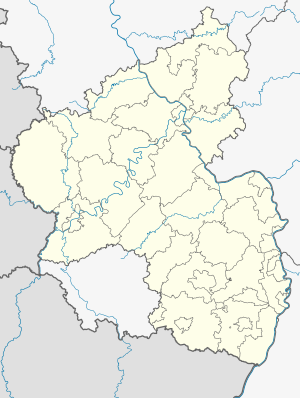Franzosenwoog tunnel
| Franzosenwoog tunnel | ||
|---|---|---|
| use | Railway tunnel | |
| traffic connection | Mannheim – Saarbrücken railway , Palatinate Ludwig Railway | |
| place | Hochspeyer | |
| length | 79 m | |
| Number of tubes | 1 | |
| construction | ||
| Client | Palatine Ludwig Railway Company | |
| start of building | 1845 | |
| business | ||
| operator | Deutsche Bahn | |
| release | December 2, 1848 | |
| location | ||
|
|
||
| Coordinates | ||
| East portal | 49 ° 26 ′ 28 " N , 7 ° 55 ′ 43" E | |
| West portal | 49 ° 26 ′ 26 " N , 7 ° 55 ′ 47" E | |
The Franzosenwoog tunnel is one of a total of twelve tunnels on the Mannheim – Saarbrücken railway line that emerged from the Palatinate Ludwigsbahn and is the second shortest after the Eisenkehl tunnel . It owes its name to the nearby French woog, which no longer exists today .
location
The tunnel is located at kilometer 56.0 on the district of Hochspeyer , whose settlement area is around two kilometers to the west. The closest train station to the west is Hochspeyer station and to the east is Frankenstein station . In this area, federal highway 37 runs parallel to the railway line . The tunnel itself shortens a loop of the Hochspeyerbach . Although originally only designed as a single track, the planum of the line was expanded to double tracks just a few years later.
history
On December 21, 1837, the Bavarian King Ludwig I gave the green light to the construction of a main line in an east-west direction from the Rheinschanze to Bexbach . Between Neustadt and Frankenstein numerous hills and foothills had to be overcome for the ascent. This required the construction of a 79 meter short tunnel in this area. Traffic from Ludwigshafen to Neustadt had already been opened in 1847, and in 1848 the Homburg – Frankenstein section followed in two stages, including the Franzosenwoog tunnel as one of two of its kind on December 2nd of that year.
Since the main line from Mannheim to Saarbrücken has always been of great importance for long-distance traffic, it was gradually electrified from 1960. The Köpfle tunnel had to be widened for electrification. This delayed the completion of the electrical operation, which could finally be started on March 12, 1964 on the entire length.
literature
- Fritz Engbarth: From the Ludwig Railway to the Integral Timed Timetable - 160 Years of the Railway in the Palatinate . 2008 ( online [PDF; 4.1 MB ; accessed on October 9, 2013]).
- Heinz Sturm: The Palatinate Railways (= publications of the Palatinate Society for the Advancement of Science. Volume 53). New edition. pro MESSAGE, Ludwigshafen am Rhein 2005, ISBN 3-934845-26-6 .
Individual evidence
- ^ Eisenbahn-tunnelportale.de: Line 3280: Franzosenwoog-Tunnel . Retrieved October 19, 2013 .
- ↑ Albert Mühl, the Pfalzbahn, p. 16
- ↑ Heinz Sturm: The Palatinate Railways . 2005, p. 53 .
- ↑ Heinz Sturm: The Palatinate Railways . 2005, p. 96 .
- ↑ Fritz Engbarth: From the Ludwig Railway to the Integral Timed Timetable - 160 Years of the Railway in the Palatinate . 2007, p. 23 f .
